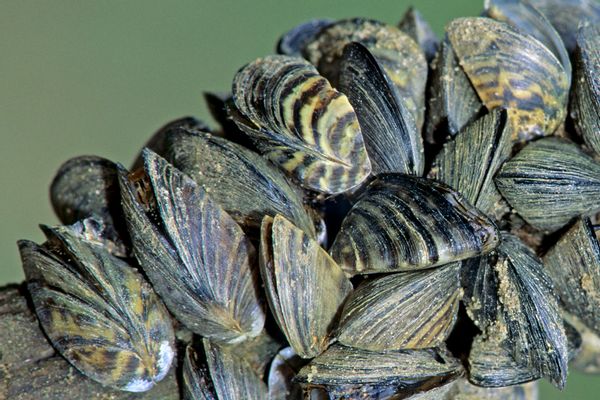
From Burmese pythons and European starlings to zebra mussels and Great Lake lampreys, the United States is in the midst of an invasive species crisis, impacting local environments both on the land and in the water. There are a number of factors making this problem worse, but foremost among them is climate change.
Dr. Robert C. Venette, a research biologist working for the United States Department of Agriculture (USDA) Forest Service Northern Research Station, is paying close attention to multiple invasive species, including "several bark beetles, emerald ash borer, spotted lanternfly, hemlock wooly adelgid, oak wilt, Palmer amaranth and Japanese knotweed, among others." But figuring out exactly how much damage they will do — and what that means for the future of the environment — isn't an easy task.
"Forecasting which invasive species will be a concern is incredibly complex," Venette told Salon. "As temperatures warm, I expect that many invasive insects, pathogens and weeds will begin to occur farther north than they have previously. Some invasive species will be active earlier in spring and summer than they have normally. Lastly, some of these invasive species may become more abundant than they have been."
Dr. Chelcy Miniat, a USDA biologist at their Rocky Mountain Research Station, identified a few variables that can help determine which species will thrive and which ones will not survive as global temperatures continue to rise.
"Scientists have identified some general factors that that could influence the consequences of climate change for a given invasive species at a given location," Miniat said. These include "direct effects of climate change on individual species," as well as "indirect effects that alter nutrients, water, or other resources available or interactions with other species or hosts" and "other factors such as human influences that can alter the environment for an invasive species, making it both harder or easier to invade."
Miniat pointed to one of the most comprehensive summaries published in 2021 that covers knowledge of invasive species in the U.S., using the expertise of over 100 leaders in invasive species research. From that report, scientists determined that the invasive vine Japanese honeysuckle (Lonicera japonica) is expanding its northern range in Eastern North America due to changing climatic conditions or that more broadly roughly 15% of invasive species can adapt and shift their ranges or environmental conditions outside of the climatic conditions in their new ranges.

By contrast Dr. Rob Progar — an entomologist and pathologist at the USDA's Sustainable Forest Management Research — told Salon that one problem with invasive species is that they reduce humanity's ability to adapt to the environmental impacts of climate change.
"The long-lasting and devastating impacts of invasive species reduce climate change resilience by altering ecosystem structure and function," Progar said. "Changing climate can also impact forest ecosystems by increasing stress due to increased temperature extremes, drought or high levels of precipitation. These stressors can render tree species more vulnerable to infection by disease, or non-native insects."
According to Progar, societies must prepare by integrating invasive species management into their climate change adaptation plans.
"Increase support for national and regional networks and programs working at the intersection of climate change and invasive species," Progar said. "Ensure early detection, rapid response and safeguarding strategies account for up-to-date climate data, projections and models. Increase investment for long-term management of invasive species that threaten climate preparedness and resilience."
Miniat says that there will need to be "strong collaborative partnerships between scientists, managers, landowners, [Indigenous] tribes and public and private agencies at local, regional, national and even global scales." Importantly "citizen science has a role to play in this as well. Because early detection is an important threshold in the response process, if people see an invasive species, reporting it is incredibly helpful. There are apps like EDDMaps that allow people to upload or record sightings of invasive species. These type of data can then be used by researchers to model invasive species spread."
One example of a species monitored through these methods is Canada's mountain pine beetle. Although native to western Canada, as winters have warmed it has spread beyond its native range, to the point where they can live in areas that previously would've been deadly for them. The beetles destroy pine trees, threatening them across Canada, where environmental agencies urge vigilant citizens to monitor them — including in the United States.
As more trees die from invasive species, their ability to capture and store large amounts of atmospheric carbon — which helps offset the impacts of climate change — is diminished, creating a negative feedback loop.
"A [Mountain pine beetle] outbreak could turn Canada’s forests from a carbon sink to a carbon source, as killed trees release stored carbon back into the atmosphere – further accelerating climate change," Progar said. At the same time, Progar said that people must "reduce nature-based solutions like carbon sequestration. We need to increase coastal communities' resilience to storms, erosion, flooding, and biodiversity loss. Together, invasive species and climate change can interact to degrade natural and built infrastructure resilience, impacting rural and urban communities. We should actively work to mitigate these impacts."
Venette also encouraged people to stay vigilant in monitoring for invasive species.
"Reporting new finds of invasive species is incredibly important," Venette said. "Free cell phone apps, like iNaturalist, make it pretty easy, even for amateurs," Venette said. "Knowing where invasive species are is a critical first step before management plans can be developed."
He also expressed optimism that, despite the damage done so far by climate change, many cherished ecosystems can still be saved.
"We are still witnessing the effects of climate changes that have already happened," Venette said. "If future climate change is limited, we would expect to slow the rate of change in some ecosystems, either through species losses or additions. As a result, we would hope those ecosystems would retain their core structure and function."







